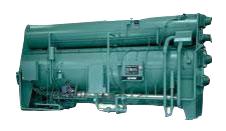Tri-Generation
Tri-Generation refers to the production of three useful forms of energy from a single energy input. The most often Tri-Generation system found, CCHP (combined cooling, heating and power), will simultaneously generate electricity, heating and cooling from the combustion of a fuel. Natural gas is often used to create steam or directly used in an engine or turbine. Tri-Generation differs from CHP/cogeneration in that the waste heat is used for both heating and cooling, typically using an absorption chiller for the cooling equipment. CCHP systems can attain higher overall efficiencies than CHP/cogeneration or traditional power plants.
Often, the acronym BCHP (building cooling, heating and power) is used for Tri-Generation applications in buildings. Heating and cooling output may operate concurrently or alternately depending on the need and the system design.
Tri-Generation has its greatest benefits when scaled to fit buildings or complexes of buildings where electricity, heating and cooling are needed on a regular basis. Such installations include, but are not limited to, data centers, universities, hospitals, military complexes, colleges and manufacturing facilities. Additional Tri-Generation Concepts Evolve Other options exist to create Tri-Generation plants. Incorporating a fuel cell unit (which utilizes biogas from a municipal wastewater treatment plant) has been developed and implemented in California. The system integrates a hydrogen purification system to recover approximately 100 kg of hydrogen per day which is used to provide a hydrogen fueling station that is open to the public and can support between 25 and 50 fuel cell electric vehicle fill-ups per day.
For more information visit the U.S. Department of Energy website here.

